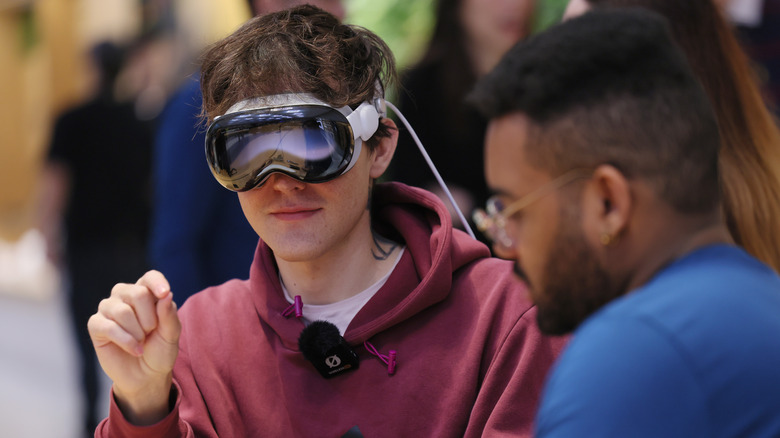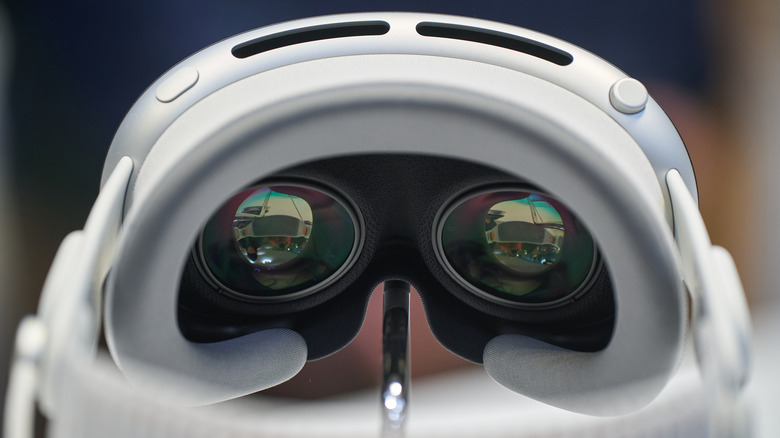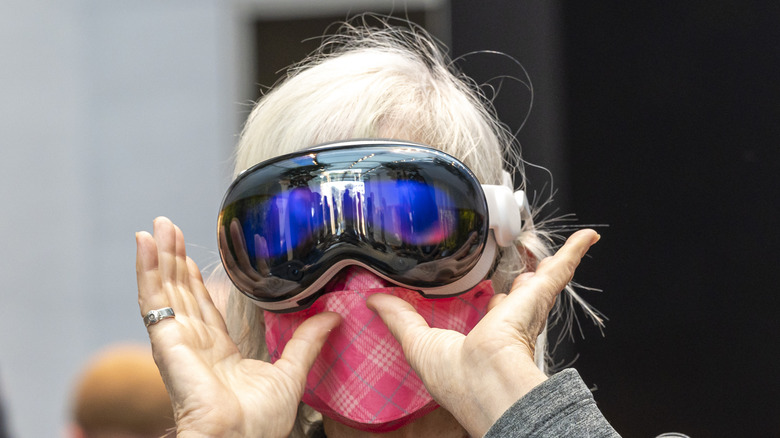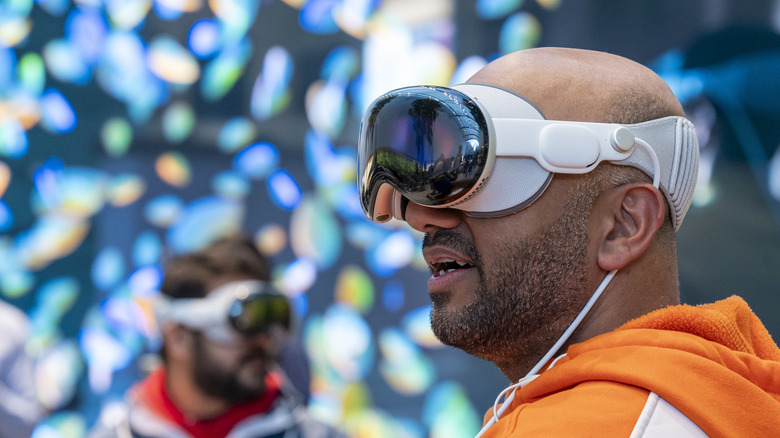The Vision Pro Is Great Tech Searching For A Purpose (Like Only Apple Can Do)
Apple's Vision Pro mixed reality headset is finally in the stores. Ahead of the retail release, CEO Tim Cook did a fancy Vanity Fair shoot wearing the headset, the first time an Apple executive was seen wearing one, and also continued his tradition of visiting an Apple Store on the first day to meet the excited fans eager to part ways with $3,500. From the reviews and first impressions that have appeared so far, the Vision Pro has emerged as an engineering marvel that is lightyears ahead of the competition at display and motion tracking tech.
It's also the first time someone has attempted a computer-on-your-face device that is served with a rich ecosystem of apps and deep bonding with a native desktop ecosystem in macOS out of the box. The biggest concern before the release of Apple's headset was the app situation. Apple says there are already over 600 unique apps ready for the Vision OS, and nearly a million iPadOS apps ready for the Vision Pro. Yes, the likes of Netflix and YouTube are taking a step back from putting their native apps on the Vision Pro. But hey, this is a spatial computer, and streaming apps are essentially an anathema for getting work done.
If the lack of a native streaming app for Netflix is concerning for you, maybe it's a terrible decision to spend $3,500 on an immersive screen that sits on your face. Maybe, get a dedicated VR headset, or the Xreal Air 2 Pro if you abhor the weight of headsets, and add a 4K TV into the cart, as well. It just doesn't make sense, unless the Vision Pro is going to be a device that enriches your work, even if it's only for a few hours and ruffles your coiffure while it's at it.
This heavy headset can't outrun cheap glasses
The whole premise of working on windows floating in the air has a few fundamental problems. There is no better way to understand the Vision Pro's flaws here than drawing an analogy with the existing breed of smart glasses, which also harbor similar dreams at a fraction of the price. I've tried XR glasses from the likes of Xreal and RayNeo. The best — and worst part — about these devices is that they are not standalone computers. They lack a processor or a battery of their own. You need to plug them into a Windows PC, a Mac, or even an iPad, in order to work with four or five floating windows in the air. You can resize them, adjust their angle, and tweak their spatial distance. All that is convenient.
Yes, there is no fancy Vision Pro-like futuristic hand and eye gesture tracking, but the biggest advantage of these "barebones" glasses is that they let you pick the ecosystem. I can switch between Windows and macOS for work, relishing in the sheer joy of seeing three giant floating monitors spanning my entire field of view. Plus, the trusty mechanical keyboard on my desk, the overpriced Logitech mouse accompanying it, or the MacBook Pro's expansive trackpad make me feel right at home with my usual computing chores.
The Vision Pro is not yet a home for serious computing work. Of the 600 native apps available for the headset, you may or may not be lucky to find a productivity app that is centered around your office work. 600 is not a meaningful figure for a device with such unprecedented ambitions, as the compatible iPadOS apps easily outnumber them. But iPadOS itself is not a full-fledged work platform.
The ecosystem problem
I have tried to move my workflow entirely to an iPad Pro with a desktop-class M1 processor and a Magic Keyboard. It looks terrific, works flawlessly, but I often run into scenarios where only a "proper" computer can do the job. That's also the reason why my iPad Pro never sits alone in my bag. There's always a MacBook or a Windows laptop for the "real" work. It's a hassle, but I've grown to live with it. Had I paid $3,500 for the dreams of spatial computing and got restricted to such an iPadOS-heavy computing ecosystem, I would be a very, very dissatisfied customer who merely bought into the hype.
But that's only one half of the equation. When you pair the Vision Pro with a Mac, you only get one macOS window in front of your eyes. "If your Mac has multiple displays connected to it, Mac Virtual Display shows only the one that you've set as the main display," says Apple. So, you essentially have paid nearly double the price of two MacBook Pro units with an M2 chip side, just to get a single large screen that can sit on your face with a 650-gram load attached to it. My Xreal Air 2 glasses cost $399, give me three massive floating macOS screens, weigh just 72 grams, and look terrific with that blue skin.
But a computer is nothing without inputs. On a traditional laptop or desktop, you look at the screen, monitoring all the functions in real time as your fingers click and tap their way on a keyboard and tracking device. In my opinion, that's what a computer should do — letting you focus on the results of your input in real-time on the screen, instead of gazing at the input process on your keyboard.
Fundamental computing dissociation
The Vision Pro brings arguably the industry's best hand and eye-tracking system for XR hardware. Unfortunately, the approach seems fundamentally antithetical to the input-output flow of a real computer. To type, you need to focus your gaze on a specific letter on the virtual keyboard, tap your thumb and index finger to confirm, and then move your gaze to the next letter. Ultimately, your attention is on the input process, which means after every bit of input, you gaze at the output to see if it's correct, and then you go back to the next bit of input. It's slow and cumbersome.
So, you return to a Mac, back to its keyboard and mouse input that is quicker and more natural for getting serious computing work done. But if that was always your objective — seeing a giant floating macOS window — why spend $3,500 when a pair of Xreal glasses can do that for less than one-eighth of that price while also giving you more virtual desktop screens and Windows OS flexibility?
Right now, the Vision Pro seems like an over-engineered piece of wearable hardware deeply tied to Apple's software ecosystem. It's a great start that beats the purpose of a wearable device that wants to do wannabe computing but fails at the basics of that same computing. Moreover, it is definitely not the best choice for your wallet. That is, of course, unless enthusiasm trumps practicality and your bank account has more zeros than you need to worry about.
Maybe, the Vision Pro is a no-hold-barred showcase for enthusiasts, and more importantly, the developers. It's a way of Apple telling them to trust in its engineering and ecosystem capabilities. Maybe, a cheaper and more practical device will build on the Vision Pro's tech. But for now, it's a pricey headset lacking computing teeth.



